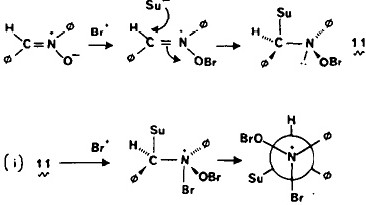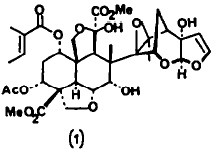Steve Jobs death on October 5th 2011 was followed by a remarkable number of tributes and reflections on the impact the company he founded has had on the world. Many of these tributes summarise the effect as a visionary disruption. Here I describe from my own perspective some of the disruptions to chemistry I experienced (for another commentary, see here).
The diagram above originates in 1983 just before the impact of Jobs’ vision burst upon chemistry. It was published in one of the new-generation of camera-ready journal, the objective being to reduce publication times from a typical 12-24 months down to around around three months. Camera-ready meant that the authors had to prepare a photo-ready manuscript; the role of these journals was to photograph, print and publish. The diagram above was prepared using stencils and Rotring technical pens together with Letraset lettering. The snippet above would probably take an hour or two to draft; the diagrams for an entire article were probably about 1 weeks work. Imagine how much time would be needed for a 200 page PhD thesis (some of this time was occupied by rushing out to a purchase more Letraset sheets because one had run out of say the letter r needed to represent the bromine in the above!). The diagram below was publishedin the same camera-ready journal in 1987.
It was produced using Chemdraw on an Apple Macintosh computer introduced in 1984 (and which reached UK chemistry departments in 1985) and printed on an Apple laser printer. It would have taken perhaps 5 minutes to produce. More significantly, by copying and pasting (terms which need little explanation nowadays), one could re-use the diagram repeatedly as a template in a more complex scheme for little extra effort. You might argue that these two diagrams do not actually differ in quality that much (actually, the Apple-derived diagrams are of much higher quality than implied above, and the loss of quality is because the article has subsequently been scanned by the journal). But in fact the impact of Jobs’ Macintosh computer was far greater than just being able to produce nice chemical diagrams. Because it also introduced chemists to disruptive new concepts, the consequences of which are still impacting today.
The first is the idea of the re-use of digital data, as mentioned above. Once one had a diagram drawn, one could use it to almost instantly derive other properties of the molecule. For example, the molecular weight or an atom connection table. This in turn could be used to start an online search. And it was the Macintosh that really bump-started the idea of online activities.
Although chemistry had started going online around 1980 (I remember a single terminal station enabling STN express online access to chemical abstracts being introduced then, and in fact computational chemists were already online around 1974), the idea of an entire department of researchers ALL being online in their lab or office was very much the result of introducing the Macintosh in 1985. It came with a network connector at no extra cost. This in turn allowed all owners of such a computer to connect online to the (then very expensive) laser printer, and as a by-product almost, to the rest of the world! I have described some of the disruption this introduced elsewhere. By around 1987, most of our Mac users were happily going online (it has to be said that owners of IBM PCs were rarely doing so at this time). That is one of the true legacies that Jobs’ disruptive technologies introduced to us chemists.
I am going to quote Samuel Butler now, writing in 1863: “I venture to suggest that … the general development of the human race to be well and effectually completed when all men, in all places, without any loss of time, at a low rate of charge, are cognizant through their senses, of all that they desire to be cognizant of in all other places. … This is the grand annihilation of time and place which we are all striving for, and which in one small part we have been permitted to see actually realised“.
Steve Jobs made a big contribution to that general development of the human race!
Tags: Apple, by-product, chemical abstracts, disruptive technologies, Historical, IBM, laser printer, Macintosh, nice chemical diagrams, online activities, online search, Samuel Butler, Steve Jobs, Tutorial material, United Kingdom


The below is a photograph of the rear of a 1985 vintage Mac.The arrow points to a "printer interface" (according to the icon just above the socket). In fact it was an Appletalk network port, and by connecting it, one got more than just a printer; one got the world (OK, provided the appropriate router was installed, in our case a Webster multigate). I would argue that this single socket on the back of the Mac is the most important one ever installed on a new computer!